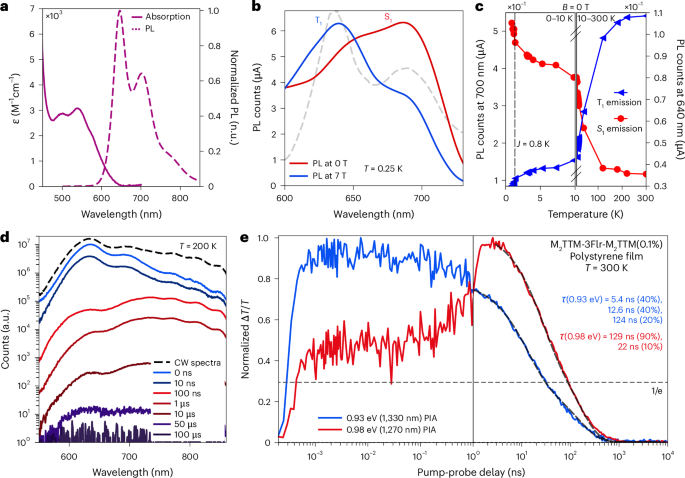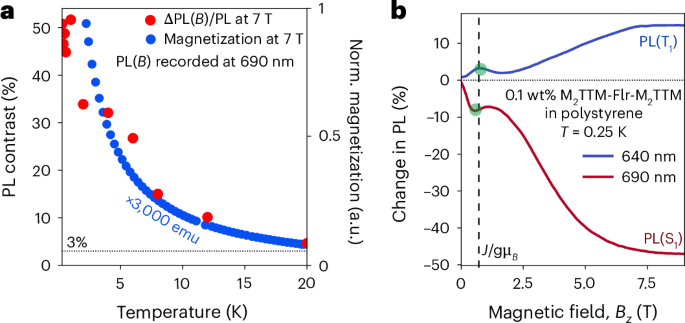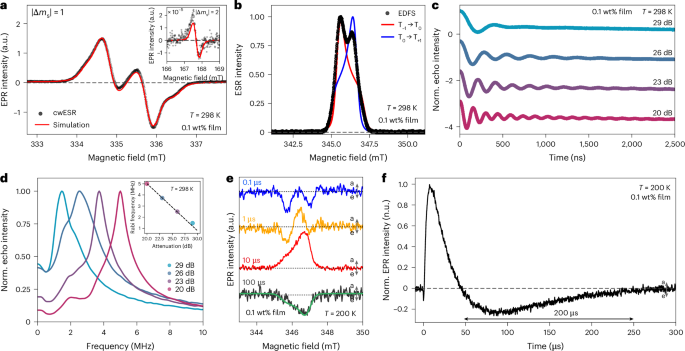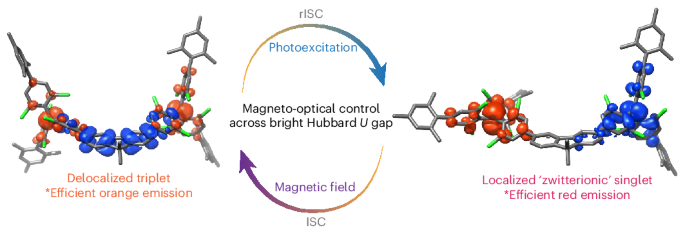Photoexcitation in the spin triplet manifold is constrained to similar non-bonding to π/π* ‘bandgap’ excitations as for the monoradicals, but in the singlet manifold, the lowest energy singlet exciton involves electron transfer from one of the radical non-bonding orbitals to the other, to form a zwitterionic exciton, as illustrated in Fig. 1b,c. It is the Hubbard U that sets the energy of the singlet exciton, and for this molecule, its energy is red-shifted from the triplet exciton. This differentiation of zwitterionic singlet from covalent triplet is critical.
Measurements presented here were carried out in dilute solutions (100 µM solutions of toluene) or in spin-coated thin films of polystyrene where the diradical concentration was ≤0.1 wt%. Polystyrene serves as a non-polar host in which the diradical can be dispersed uniformly. We find it necessary to keep these diradical molecules well separated through dilution to prevent intermolecular energy and spin transfers. At these concentrations, the aggregation effects are unimportant (Supplementary Information Section 12). The samples for PL-detected magnetic resonance (PLDMR) were prepared by doping diradicals at 1 nM concentration into 1,3,5-trichlorobenzene crystals.
Figure 2a shows the absorption and PL spectrum of 100 mM toluene solution of M2TTM-3Flr-M2TTM. We note that this diradical has approximate alternant symmetry that imposes electron-hole symmetry38,39 so that the lowest absorption band has similar but opposing contributions from π → non-bonding and non-bonding → π* transitions. The diradical shows efficient PL, red-shifted from the monoradical (Supplementary Fig. 6), with a peak emission at 640 nm and PLQE above 90%. We note that there is a second peak in the PL near 700 nm, which, very importantly, is not just a vibronic overtone but is due to a spin-singlet excited state, while the 640 nm feature is due to a spin triplet excited state. The distinction between these two emission bands is most easily seen in magnetic-field-dependent PL, measurements at low temperatures, as shown in Fig. 2b. In brief, at 0.25 K, the ground state is a spin singlet (with emission at 700 nm) but with an applied magnetic field (above 0.6 T), the ground state switches to the triplet and the emission at 640 nm is from the triplet exciton.
Fig. 2: Photophysics of the luminescent diradical.
a, The absorption and PL spectra for M2TTM-3Flr-M2TTM. The spectra were acquired under ambient conditions following a 532 nm excitation in a 100 μM toluene solution. n.u., normalized units. b, The magnetic-field-dependent PL spectrum of the M2TTM-3Flr-M2TTM diradical recorded at 0 (red) and 7 T (blue) at 0.25 K. The steady-state PL spectrum at 300 K is also show for reference (grey, dashed) c, Zero-field temperature-dependent PL at 640 (blue triangles) and 700 nm (red circles) from 300–0.6 K. The break point in the graph is 10 K. d, The time-resolved and continuous-wave PL for M2TTM-3Flr-M2TTM at 200 K. CW, continuous wave. e, The kinetic traces of the PIA features at 520/1,330 nm (blue) and at 610/1270 nm (red) from the transient absorption spectra and the associated fits (dashed lines) for a multiexponential decay model. The exponential decay constants and weights are quoted in the figure. The PL data for all plots were obtained from a M2TTM-3Flr-M2TTM(0.1%):polystyrene doped polystyrene film following a 532 nm excitation pulse at a fluence of 6 μJ cm−2.
The differentiation between the singlet and triplet excitons is at the core of our results. The triplet exciton is red-shifted from the monoradical by 0.1 eV, (Supplementary Fig. 4b), but the energy of the zwitterionic singlet exciton is given by a Hubbard U and is further red-shifted. We observe that the energy of the singlet PL (700 nm, 1.8 eV) matches the difference in energy between the electrochemical potentials for reduction at −1.2 V (versus Fc/Fc+) to the anion and for oxidation at 0.6 V to the cation, shown in Supplementary Fig. 4. The origin of high PLQEs in some of the radical donor–acceptor systems has been explored by Ghosh et al.40. In this model, electron-hole separation to vibrationally decoupled molecular fragments in the zwitterionic singlet exciton is responsible for the high PL yield in spite of the long radiative lifetime.
Figure 2c shows the temperature-dependent PL intensity in 0.1 wt% spin-coated thin films of the 640 and 700 nm peaks in the 300–0.6 K regime. The 700 nm PL increases while the 640 nm PL decreases at lower temperatures, although the integrated-PL intensity does not change (Supplementary Fig. 13). The slope of the curves changes twice: first at ~120 K and second at ~1.0 K. We first assign the initial slope-change event to the thermal energy of the system falling below the activation energy for rISC and second when it falls below the antiferromagnetic exchange energy of the diradical.
Figure 2d shows time-resolved PL measurements at 200 K on the 0.1 wt% doped polystyrene films. The M2TTM-3Flr-M2TTM diradical shows emission from the triplet, peaked at 640 nm, with a fast lifetime of 10 ns and slower emission from the singlet, peaked near 700 nm, with a delayed lifetime of 100 ns and beyond. Analysis of emission before and after 50 ns shows about equal contributions from the triplet and singlet spectra (Supplementary Fig. 8). Although the initial decay of the 640 nm feature is fast it shows a temperature-dependent long-lived component, and this slow component has an activation energy around 10 meV (Supplementary Fig. 12). We consider the slow component of the 640 nm emission to be due to rISC. We note that we are fortunate to observe efficient singlet emission even though it is slow, but nevertheless, we are not able to measure absorption from the spin-singlet ground state, S0 to the first spin-singlet excited state, S1 because the oscillator strength is low.
Figure 2e shows kinetic traces of the main peaks obtained from transient optical absorption spectroscopy. A detailed report and analysis of transient optical absorption studies is provided in Supplementary Information Section 6, and associated quantum chemical modelling is provided in Supplementary Information Section 10.6. In summary, the photoinduced absorption (PIA) bands near 520 nm (2.05 eV) and 1,330 nm (0.93 eV) are associated with the triplet exciton before charge separation26. The PIA bands centred at 610 nm (2.28 eV) and 1,270 nm (0.98 eV) build up over the first 3 ns and are associated to the absorption of the zwitterionic singlet exciton formed after charge separation. The kinetics of the PIA bands associated with the exciton before and after charge separation are in agreement with the kinetics of the 640 and 700 nm PL peaks, respectively. The triplet and singlet PIA features cross over before 1 ns; this can be attributed to the intersystem crossing (ISC) process.
Figures 2b and 3a,b show magneto-optical studies. We find that the 640 and 700 nm emission features are strongly dependent on applied magnetic field (Fig. 2b). In the ground state, the two spins, localized on each of the M2TTMs, are weakly antiferromagnetically coupled, as shown in the temperature-dependent magnetization curves in Fig. 3a, with an antiferromagnetic exchange energy near 1 K. This is also captured using PL through the rise in 700 nm and fall in 640 nm emission below 1.2 K, shown in Fig. 2c. In summary, the 700 nm emission dominates at zero field, where only the singlet state is occupied at low temperatures, and as the field is raised above 0.6 T where the Zeeman energy exceeds the exchange energy, the triplet becomes predominantly occupied, and the 640 nm emission dominates. We associate this with a magnetic spin triplet ground state. Figure 3b shows evidence for a resonance where the Zeeman energy equals the ground state exchange energy. In the region close to exchange, we obtain PL spectra that are linear combinations of the singlet and triplet PL which are proportional their relative populations (Supplementary Figs. 17 and 18).
Fig. 3: Magneto-optic response.
a, The temperature dependence of the MPL contrast at 7 T (red) for the 700 nm emission compared with the temperature dependence of the magnetization at 7 T (blue), measured using SQUID magnetometry. Norm., mormalized; emu, electromagnetic unit. b, The PL intensity versus magnetic field at 0.25 K, measured on a M2TTM-3Flr-M2TTM(0.1%):polystyrene doped polystyrene film with 400 nm laser excitation at −2.
We note that the field and temperature-dependent PL matches the magnetization measurements shown in Fig. 3a. This establishes that the two emissions are associated with the magnetization of the sample arising from the two possible overall spin states, namely singlet at 700 nm and triplet at 640 nm.
We have assembled a photophysical model with the available experimental information in Fig. 1d. We can assume that the initial photoexcitation occurs via fluorene π/π* to non-bonding transitions due to the similarity of the absorption spectrum of the diradical to the monoradical (Supplementary Fig. 6). These new states can be of either singlet or triplet multiplicity, denoted as S1 and T1 respectively. Extension of the exciton to both radical units will be dependent on molecular geometry, and Fig. 1b illustrates the singlet with zwitterionic character. We have explored this by running extensive time-dependent density functional theory calculations on the M2TTM-3Flr-M2TTM diradical paying particular attention to the role of dielectric and geometric relaxation (Supplementary Information Section X. The approximate electron-hole symmetry yields a T1 triplet exciton with finite oscillator strength (the state involves dominant CT excitation between the fluorene and the TTM) translating into a radiative lifetime of ~20 ns, irrespective of the dielectric constant and in reasonable agreement with experiment. By contrast, the S1 singlet state radiative decay is very sensitive to both dielectric and geometric (mostly conformational) relaxation effects. This is because the zwitterionic singlet state acquires finite oscillator strength only through wave function mixing with the singlet counterpart of the 3CT excitation, and such mixing varies strongly with their energy separation. Thus, the quasipure zwitterionic state, as formed after full dielectric (at e = 2.37 or above) relaxation, has a vanishingly small oscillator strength and a radiative lifetime larger than 1 μs. By relaxing only the optical part of the dielectric response at n2 ≈ 2 (where n is the refractive index of the medium), we instead obtain a hybrid zwitterionic-1CT state with radiative lifetime of ~50 ns in the Franck–Condon region and of ~200 ns when relaxing only the high-frequency contribution of the lattice relaxation (thus freezing the conformation of the molecule to that of the ground state), rates bracketing the measured value. Full conformational relaxation brings the S1 state further down in energy, resulting again in a radiative lifetime in the microsecond range. We consider this is either at least partly alleviated by steric effects in the solid phase or that thermal fluctuations allow populating higher-energy conformations and/or local dielectric environments where finite zwitterionic-CT mixing occurs.
This zwitterionic singlet exciton is a very unusual excitation for a molecular semiconductor, but its excitation energy, the Hubbard U, is a very well recognized quantity for many inorganic oxides. There is extensive literature on Mott–Hubbard models for transition metal oxides, including superconducting cuprates and nickelates1. In general, the Hubbard U is typically above 2 eV and is larger than other electronic excitations, such as metal to oxygen charge transfer. There has been little consideration about optical absorption and emission to and from the Mott–Hubbard charge transfer state, but there is a recent report on ‘Hubbard excitons’ in SrIrO4 (ref. 41). For our organic radical systems we are able to bring the Hubbard U below the lowest interband exciton, and it is this that allows us to observe the Mott–Hubbard exciton through its PL. The special feature of our studied material is the efficient dual fluorescence from both the triplet and singlet excited states with near unity quantum yield. Matsuoka et al.21 report evidence for singlet emission associated with magneto-PL (MPL) in a weakly luminescent diradical system but do not identify the singlet exciton as zwitterionic. We have explored other systems with different bridging units, including carbazole, presented in detail in the Supplementary Information. These show no evidence for PL from singlet excitons. The carbazole-linked system shown in Supplementary Fig. 5 is very similar to that reported by Mizuno et al.20 and shows only triplet emission. This is also the case for a recently reported phenyl-linked system22.
Since the ground state exchange energy is low (~0.8 K), we expect a 3:1 ratio of triplet:singlet ground states down to low temperatures. We observe however that the ratio of triplet to singlet PL near 300 K is closer to 1:1 (noting that the overall PLQE is >90%) and consider this must arise through ISC from triplet to singlet. The TA evolution shown in Fig. 2e shows this happens beyond 100 ps. We assign the thermally activated delayed emission at 640 nm to rISC, from the S1 to the T1 state (we note also that the energy of the emitted photon does not capture the full internal energy of the singlet exciton, and we consider there is a conformational energy contribution to the singlet exciton that is not available for photon emission). These observations of competing singlet and triplet excitation and de-excitation pathways, alongside evidence for ISC and rISC, sets up scope for photoexcited spin polarization in the ground state.
We carried out ground and excited-state ESR measurements, on 0.1 wt% doped polystyrene thin films containing M2TTM-3Flr-M2TTM (see the Supplementary Information for 50 µM toluene solutions). In the dark, continuous-wave ESR (cwESR) measurements at 298 K (Fig. 4a) shows clear evidence for triplets with full-field |Δms| = 1 transitions which could be simulated with D = 30.3 MHz and E = 1.6 MHz. Further confirmation of a ground state triplet state is given by the observation of a |Δms| = 2 transition at half field.
Fig. 4: Photoinduced long-lived ground-state spin polarization.
a, Half-field (left) and full-field (right), dark, continuous-wave X-band ESR spectra at 298 K which show the |Δms| = 2 transition in a 0.1 wt% doped polystyrene film (black dots) and the simulation (red line) of all features as a triplet species. b, The EDFS spectrum of the diradical. c, Rabi oscillations measured at the 345.62 mT transition using different microwave powers. d, The Rabi-frequency spectrum plotted for different microwave powers. The inset shows the shift in the peak frequency with decreasing microwave attenuation, and we observe an expected frequency decrease for every 3 dB increase in attenuation. e, trESR spectral slices derived at the beginning of each temporal decade (102 to 105 ns) of a 0.1 wt% doped polystyrene film of M2TTM-3Flr-M2TTM diradical at 200 K. The spectra are obtained at the quoted time point after a 532 nm laser excitation lasting for 5 ns, which repeats at a frequency of 100 Hz. The data highlight the long-lived photogenerated spin-polarized ESR signals persisting beyond 200 μs. The simulation of the 100 μs slice (green solid line) confirms polarization in T+. f, The kinetic traces of the trESR signal in the 345–348 mT region, which is the kinetics of light-induced spin polarization observed from the ESR signal, for the 0.1 wt% doped polystyrene film at 200 K (black solid lines) of the M2TTM-3Flr-M2TTM diradical. Norm., normalised; a, absorption; e, emission; n.u., normalized units.
Ground state pulsed ESR was performed, and the resulting echo-detected field sweep (EDFS) shows two peaks, due to the T−1 → T0 and T0 → T+1 transitions (Fig. 4b). Echo decay measurements at the two peak positions behave similarly; an exponential decay fit (Supplementary Figs. 46 and 47) gives the phase memory time, Tm, of 950 ns. The long Tm is comparable with that of a perchlorotriphenylmethyl monoradical42. Inversion recovery experiments show that the T1 (spin-lattice) relaxation time is 31.8 μs. As Tm is clearly not limited by T1, creating a nuclear-spin free environment could further increase the Tm (ref. 43).
One critical component for molecular systems to be utilized in quantum information applications is the ability coherently manipulate the spin state44. Rabi nutation experiments shown in Fig. 4c, show the ability of this system to be coherently driven between two states with multiple oscillations seen at room temperature under relatively low microwave powers. We also observe an expected linear shift in the Rabi-oscillation frequency with increasing microwave power, shown in Fig. 4d.
Transient ESR (trESR) was measured with a 532 nm, 5 ns pulsed photoexcitation. Figure 4e shows spectra measured at different times after excitation. At the timescales shown here, we consider the dominant response to arise from non-thermal spin sublevel populations in the electronic ground state formed by the decay of photogenerated excitons. We note here that the triplet luminescence response has an initial decay time of 10 ns. At 100 ns and 1 µs, two emissive features are observed, which we consider arise from sublevel transitions in the triplet state, with preferential population in the T0 and T+ sublevels. This indicates either preferential filling of the T0/T+ or depopulation of the T− spin-levels, the latter via ISC in the excited state to the singlet with spin sublevel selective transition probabilities. At 10 µs, the spectra show a broad absorptive feature and beyond 50 µs this ESR feature reverses sign to become emissive and is measurable beyond 200 µs (Fig. 4f). A similar trESR response is found in frozen solution spectra at 150 K, with the only difference being the initial emissive feature to much more pronounced (see Supplementary Figs. 48 and 49 for two-dimensional maps). Note that the 5 ns pulse excitation (100 Hz repetition rate) is shorter than the PL lifetime and precludes spin pumping via re-excitation. A possible mechanism for the sign reversal (Fig. 4e) is spin sublevel selective excited-state depopulation6,45. The later time sign reversal shown in Fig. 4e,f is very unusual, and we consider requires spin repopulation from an excited-state reservoir46. A possible mechanism to provide this repopulation channel is by rISC from the reservoir of long-lived excited-state singlets which persists to these timescales at 200 K (Fig. 2c and Supplementary Fig. 11). We confirm the long-lived photogenerated spin polarization beyond 50 µs to be due to overpopulation of the ground state T+ sublevel by simulation of the late-time trESR spectra where we require a ground state triplet population, p(Ti), distribution of p(T+) > p(T0) = p(T−1) but with the same D and E parameters as for the cwESR dark spectrum.
Ground-state spin polarization mediated by a spin–optical interface can be revealed in PLDMR measurements. We explore a range of PLDMR conditions in Fig. 5. The Zeeman energy exceeds D above 2.8 mT, so at X-band (Fig. 5a) and D-band (Fig. 5b), the triplet levels are set by the applied B||z fields (Fig. 5c). At 100 K and X-band ESR conditions, in Fig. 5a, we see that the PLDMR recorded in the range 590–650 nm shows a contrast >10−3%. We report low temperature wavelength-resolved PLDMR under D-band conditions in Fig. 5b, showing suppression of the triplet emission and enhanced singlet emission at magnetic resonance. The PLDMR transition is large with ΔPL/PL contrast ~10% and has a narrow 2 mT spectral width, shown in Supplementary Fig. 35, reminiscent of the dark-cwESR spectrum of the diradical. This behaviour arises due to preferential spin-selective ISC from the ms = 0 sublevel of the triplet excited state to the S1 state, as shown in Fig. 5c, which is turned on by microwave pumping at resonance by the spin sublevel T−1 → T0 transition in the ground state before photoexcitation (see Supplementary Information Section 5 for more details). The mechanistic insights for the quantum mechanical origins of PLDMR responses from alternant diradicals has also been recently and independently explored by Poh et al.47. The size of the PLDMR response is relatively agnostic to microwave and laser excitation power (Supplementary Figs. 35 and 36) but scales with sample magnetization following a Curie-like law, as seen in Supplementary Fig. 34.
Fig. 5: Spin–optical interface in diradicals.
a, X-band ESR conditions (9.7 GHz, 0.346 T) ΔPL/PL >10−3% at 100 K. We probe the spin–optical interface using probed using PLDMR spectra. ODMR, optically detected magnetic resonance; fMW, frequency of the applied microwave. b, The spectrally resolved PLDMR under conditions at the PLDMR resonance point at 4.1835 T. All PL detected in a–c and utilized a long-pass filter (>420 nm) to cut-off the laser line. APD, avalanche photo-diode; MW-ON, microwave on; MW-OFF, microwave off. c, An illustration of the proposed spin-selective ISC mechanism for the observed PLDMR behaviour. At Bz > 0.7 T and T ms = −1 sublevel in the ground state triplet is occupied, which has a small ISC probability. Bz is the static magnetic field applied along the z-axis. When microwaves are switched on (right), a microwave-induced Δms = 1 transition drives population from ms = −1 to ms = 0 within the ground state. This ms = 0 sublevel has a higher probability for ISC in the excited state, which leads to more singlet PL and reduced triplet PL, manifest as a large PLDMR contrast. The samples for a were thin films made with 0.1 wt% M2TTM-3Flr-M2TTM doped into polystyrene, and in b, we doped 10 nM of M2TTM-3Flr-M2TTM into PhCl3 crystal. The crystals were prepared using slow evaporation of a solution, which were subsequently washed and polished, as described in Supplementary Information Section 13.
